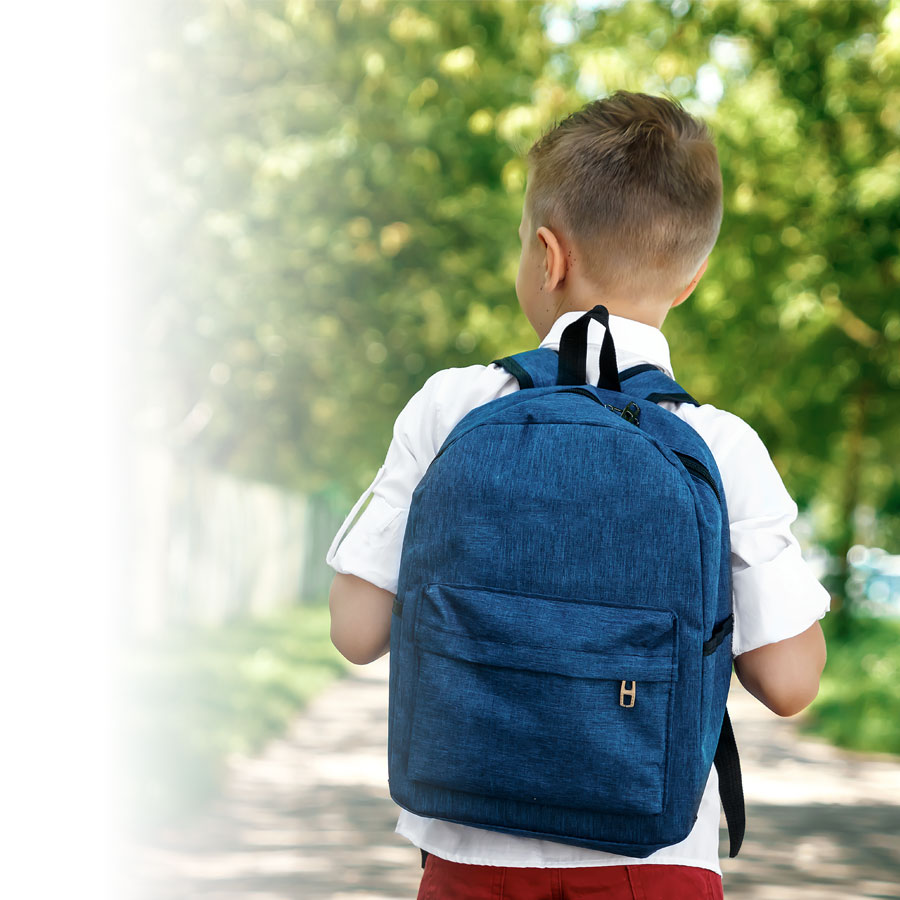Buying a backpack at the start of the school year is no trivial matter! It has to please your child, of course, but also keep their back healthy. Here are a few tips to help you choose the right backpack for your child.
How to choose the right backpack for your child?
Back-to-school season is fast approaching, and with it, the school supply shopping rush. The list of supplies to buy can sometimes be daunting, as can be the weight of the backpack used to carry them! It is important to choose your school bag carefully, as it will follow your child throughout the school year. Choose a backpack that's ergonomic, economical and sturdy.
Did you know that over 60% of children carry backpacks that are too heavy for their body weight, and that many carry them incorrectly? This can have serious long-term consequences for their posture.
Here are a few examples of common behaviours and their consequences:
- Carrying a backpack on one shoulder, which can sometimes cause postural problems;
- Carrying a heavy bag, or unadjusted straps; in both cases, the child often compensates by leaning forward, which can eventually lead to shoulder and neck strain.
So young and already having back problems? Adult exercises are also good for younger children. Check out our article Preventing and treating back pain, and get your kids to adopt good practices.
Adapting the choice of backpack to the school level
➤ What is the best backpack for kindergarten?
For little ones, the best backpack is characterized above all by its extreme lightness (ideally less than 300 g when empty) and its mini size (8–12 L) so that it does not overload their developing posture. Choose a model with thin straps, lined with soft foam and fitted with an easy-to-engage chest clip: it holds the bag in place without impeding movement.
➤ What is the best backpack for elementary school?
Younger children need a compact (15-18 L), lightweight and colourful bag. Choose the best elementary school backpacks with playful designs, ergonomic back foam and straps that are easy to adjust.
➤ What is the best backpack for high school and college?
From college school onwards, the volume increases to 20-25 L to accommodate textbooks, binders and, if necessary, a laptop. Look for a padded electronics pocket and side reinforcements. Urban models often offer a more sober design, while remaining adapted to school constraints.
➤ What are the differences between a boy's backpack and a girl's backpack?
The child's size and shape (wider or narrower back) remain the main criteria: always make sure you choose a backpack whose cut and adjustments fit your child's morphology, whatever their gender.
What are the key criteria for choosing a child's backpack?
To avoid unnecessary injuries and take care of a growing spine, here are some things to consider when shopping for a school bag:
➤ Ergonomics and fit
A bag should be no higher than shoulder height and no lower than the lumbar region. A padded back and wide, padded, adjustable shoulder straps ensure a comfortable fit.
➤ Weight and capacity
Choose a lightweight model in sturdy fabric (polyester, nylon) with several compartments. The golden rule: The empty bag must weigh no more than 10% of the child's body weight.
➤ Load distribution
Compartments make organization easy and avoid concentrating weight in one place. Chest and hip straps stabilize the load and relieve shoulder strain.
➤ Durability and maintenance
A school bag undergoes many tests: falls, rain, rubbing. Choose reinforced seams, a waterproof bottom and easy-to-clean fabric.
➤ Safety details
Reflective strips, bright colours, and identification labels are valuable assets for visibility and parents' peace of mind.
How do you know if a school backpack is good quality?
Not all bags are created equal: A brand name is not always a guarantee of reliability. Before purchasing, test the bag in the store: adjust the straps, load it up, and walk around with it. A premium bag features:
- High-density, water-repellent or waterproof fabric;
- YKK* zippers or equivalent, sturdy and smooth;
- Double-stitched seams on high-demand areas (handles, base, straps);
- Technical reinforcements such as moulded back plates.
Did you know?
*YKK stands for Yoshida Kōgyō Kabushiki Kaisha, a Japanese company founded in 1934 and now the world's largest manufacturer of zippers. When you see "YKK closure" on a bag or garment, it guarantees:
- Robustness and longevity;
- Smooth operation;
- High standards.
How to use a backpack to avoid back pain?
Here are a few tips for optimal and safe use of the backpack:
- Keep the weight of the backpack below 10% of your child's body weight (the best way to calculate this is to weigh the child without the backpack, then with the backpack).
- Ideally, your child should place the bag on a surface at the right height (a table, for example) before putting it on.
- Make sure your child only carries what they need by doing a little weekly tidying up.
- Encourage your child not to carry the bag on their back when it is not necessary (for example, while waiting for the bus). Their back deserves a break.
More tips for a healthy back
In addition to a well-fitting bag, a few other habits help to maintain good spinal health:
- Varied physical activities (swimming, junior yoga, team sports);
- Quality footwear with good cushioning and support;
- Morning muscle wake-up: Gentle stretching before class.
Remember that strength and load-bearing capacity are not measured by your child's size, and that the choice of bag is just as important as the way they carry it!
Choosing the best backpack for your child depends on balancing ergonomics, lightness and sturdiness. Remember to follow the usual rules to avoid overloading and ensure your child has a safe start to the new school year. Have a healthy back-to-school!

